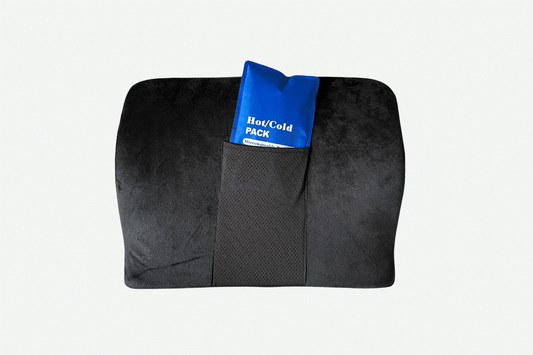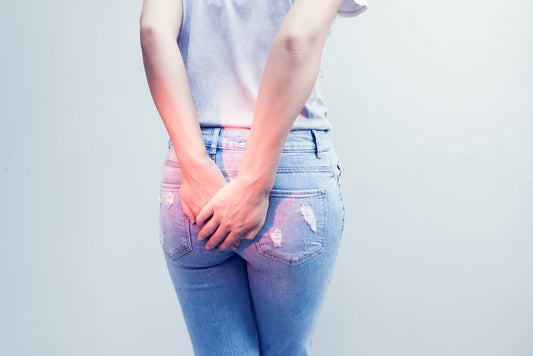Hemorrhoids High Fiber Diet - Best and Worst Foods
Robert Cutler, D.O., FAOCPrShare
Have you thought about your New Year’s resolutions yet? A YouGov survey revealed that 43% of Americans aspired to eat healthier in 2020.
Eating habits are often based on convenience and familiarity. The foods you’ve eaten since you were a child may not agree with your body anymore. As we get older, we develop heartburn, high cholesterol, or new allergies. So, we must adjust our diet to avoid the adverse effects of certain foods.
Those who are prone to hemorrhoids also have an opportunity to improve their condition with dietary changes. Getting plenty of fiber and staying hydrated works in tandem as part of an anti-hemorrhoid diet.
One of the most effective ways to avoid those bathroom issues that lead to hemorrhoid inflammation is to maintain regular and easy bowel movements. We accomplish this by increasing fiber intake and avoiding those constipation-creating foods that cause hemorrhoids.
We’ll share our best tips for helping hemorrhoids with a high fiber diet so you can make a dietary fiber plan that works best for your lifestyle.
Why Do You Need a High Fiber Diet?
While shopping in your typical grocery store, you’ll notice that some food labels call out the fiber quantity right on the front. There are even products that even have the word “fiber” in their brand name to market fiber content as a primary benefit.
High fiber content is a selling point for products because of the spectrum of health benefits it offers.
- Weight management: Those who get enough fiber have been successful at losing weight and keeping it off.
- Improved nutrition: Fiber helps the body gain beneficial nutrients.
- Natural detox: Fiber cleanses the body of waste, excess, and unhealthy fats.
- Heart health: Getting enough fiber can lower your chances of cardiovascular disease and cancers.
- Gut health: Fiber promotes beneficial bacteria in your digestive tract.
- Blood sugar maintenance: Fiber slows down the absorption of sugar to keep blood sugar levels balanced.
- Cholesterol control: Fiber keeps bad cholesterol in check.
- Optimal bowel movements: Combined with getting enough water, fiber intake optimizes stool transit time, so it is key in a diet for hemorrhoid sufferers.
Perhaps the most common reason people increase their fiber intake is for bowel movement improvement, and as they do so they reap a whole host of other health benefits (as listed above).
The Two Types of Fiber

For the most part, fiber comes from plant-based foods. Natural fiber sources are legumes, nuts, seeds, vegetables, fruits, grains, and chitin from shellfish.
While edible, the fibrous parts of these plants are not broken down by digestion, so they bind with the waste that is excreted. We ingest fiber in two forms: soluble and insoluble. While plant-based foods we consume usually supply both soluble and insoluble fiber, the benefits of each vary.
Soluble Fiber
Soluble fiber includes plant gelling agents and can be dissolved in water. The pectin and gums from this type of fiber become gelatinous when it mixes with water.
Soluble fiber’s health benefits are blood cholesterol and blood sugar reduction (to help with blood glucose control to mitigate diabetes risk).
Insoluble Fiber
Insoluble fiber differs in that it will not dissolve in water. Its construction is of plant cellulose and hemicellulose.
Insoluble fiber draws water into stools so that they are softer and easier to move out without straining the rectal muscles. Like soluble fiber, it also helps manage diabetes by enhancing insulin efficacy.
What Fiber is Best for Hemorrhoids?
While soluble fiber does a body good, insoluble fiber is what has a direct impact on regularity and bowel movement. However, you do need both for a nutritious hemorrhoids high fiber diet.
To get the most benefit from fiber, you should plan for it to be a part of your regular daily diet. Men should take in about 38 grams of fiber per day while women should aim for about 25 grams per day. Once you enter your fifties and sixties, this amount reduces to 30 grams for men and 21 grams for women.
But before you get started on this new hemorrhoids diet regimen, don’t start off with the full recommended amount. You want to reach this target incrementally so your body has time to get used to it. Taking in more fiber than usual may cause bloating and gas.
The target ratio for dietary fiber is ⅔ insoluble and ⅓ soluble. Also, fiber works best for hemorrhoids when your body is well-hydrated by drinking plenty of water.
What Should You Not Eat When You Have Hemorrhoids?
As discussed at the beginning, many Americans start off a new year eating a healthier diet as their goal. This often means cutting out many of the foods that we are in the habit of eating.
The digestive system is more sensitive for some than others. For example, those who are lactose intolerant can have an adverse reaction if they eat even a little bit of dairy.
To ensure our time in the bathroom isn’t regrettable, here are some foods to consider eliminating or greatly reducing in your diet.
Examples of what not to eat when you have hemorrhoids are:
- Dairy products such as milk, cheese, ice cream, etc.
- Junk food like fast food and chips.
- Processed food such as hot dogs, frozen meals, and snacks.
- Too much meat.
- White bread and bagels (whole grains are better).
- Processed foods, such as hot dogs and some microwavable dinners.
- Dehydrating products such as alcohol, caffeine, and salty foods.
- Spicy Foods (they contribute to irritation).
- Nuts, seeds, corn, and popcorn (the undigested remnants will scrape the hemorrhoid lining).
These listed above do not provide the necessary fiber content for your hemorrhoids high fiber diet. Foods that cause hemorrhoids do so by contributing to constipation and irregular bowel movements. We mitigate this risk by cutting out foods to avoid with hemorrhoids.
What Should You Eat When You Have Hemorrhoids?

For those with IBS and hemorrhoids, food intake choices affect daily wellness. Eating foods that make us constipated or don’t offer enough fiber causes problems with habitual consumption.
Instead, those who are prone to hemorrhoids should eat those foods that give you adequate nutrition while promoting healthy bowel movements. The hemorrhoid high fiber diet is about getting back to the basics of healthy eating.
Fruits and Vegetables
The 2020 Dietary Guidelines for Americans recommends two and a half cups of vegetables per day and two cups of fruit per day. Fruits and veggies are packed with nourishment including fiber.
Top 10 Fiber-Rich Fruits
- Passion fruit: 25g per cup (soluble: 0.5g, insoluble: 1.4g per serving).
- Avocado: 13g per cup (soluble: 5.8g, insoluble: 3.4g per serving).
- Guava: 9g per cup (soluble: 7.4g, insoluble: 1.5g, per serving).
- Raspberries: 8g per cup (soluble: 7.5g, insoluble: 0.9g, per serving).
- Blackberries: 8g per cup (soluble: 6.2g, insoluble: 1.4g, per serving).
- Pomegranate: 7g per cup (soluble: 0.8g, insoluble: 0.2g, per serving).
- Persimmon: 6g per cup (soluble: 5.3g, insoluble: 0.8g per serving).
- Kiwi: 5g per cup (soluble: 2g, insoluble: 0.6g, per serving).
- Pear: 4g per cup (soluble: 1.8g, insoluble: 2.2g per serving).
- Orange: 4g per cup (soluble: 1.3g, insoluble: 1.8g, per serving).
Top 10 Fiber-Rich Vegetables
- Lima beans: 13g per cup (soluble: 6.2g, insoluble: 7g, per serving).
- Acorn squash: 9g per cup.
- Green peas: 9g per cup (soluble: 6.2, insoluble: 2.6, per serving).
- Collard greens: 8g per cup (soluble: 2.1g, insoluble: 3.2g, per serving).
- Artichokes: 7g in one medium whole (soluble: 3.93g, insoluble: 1.8g, per serving).
- Butternut squash: 7g per cup (soluble: 1.9g, insoluble: 1.4g, per serving).
- Parsnips: 7g per cup (soluble: 2.6, insoluble: 3.6).
- Kale: 5g per cup (soluble: 1.2g, insoluble: 1.4g, per serving).
- Broccoli: 5g per cup (soluble: 2.3, insoluble: 2.3, per serving).
- Carrots: 5g per cup (soluble: 3g, insoluble: 2.2g, per serving).
If you were to select the two lowest-ranked of each list to put a serving of each in your meal prep, you’d have about 18 grams of fiber for the day. This is roughly half of the recommended daily allowance of fiber. So as you can see this category is rich in fiber content and perhaps the best food for hemorrhoids.
Beans, Lentils, and Nuts
In addition to bringing flavor to your meals, this category is also rich in nutrients and fiber. Beans are known for being cheap yet healthy, lentils are a healthfood staple, and nuts are yummy (but can be high in fat and can scratch the lining).
Common Legumes and Nuts:
- Black beans: 5.3 per cup (soluble: 3.9g, insoluble: 1.4g, per serving)
- Pinto beans: 14.7g per cup (soluble: 10.9g, insoluble: 3.8g, per serving)
- Garbanzo beans: 12.4g per cup (soluble: 9.8g, insoluble: 2.6g, per serving)
- Lentils: 15.6g per cup (soluble: 14.4g, insoluble: 1.2g, per serving)
- Almonds: 15.9g per cup (soluble: 14.3g, insoluble: 1.6g, per serving)
- Walnuts: 5.8g per cup (soluble: 4g, insoluble: 1.8g, per serving)
- Peanuts: 13.2g per cup (soluble: 10.5g, insoluble: 2.7g, per serving)
With most of these listed exceeding 10 grams, a serving would make up about a third of the daily amount of fiber needed.
Grains

Carbohydrates round off a dinner plate whether it’s some steamy rice or a slice of crusty bread.
Common Grains:
- Multigrain bread: 2.8g per cup (soluble: 1.6g, insoluble: 1.2g, per serving)
- Whole wheat rolls: 2.5g per cup (soluble: 2.1g, insoluble: 0.4g, per serving)
- Oatmeal: 3.9g per cup (soluble: 2.1g, insoluble: 1.8g, per serving)
- Bran cereal: 6.7g per cup (soluble: 6g, insoluble: 0.7g, per serving)
- Brown rice: 3.5g per cup (soluble: 3.3g, insoluble: 0.2g, per serving)
From this list, we see that these healthy grains do have fiber but not as much as fruits, veggies, and legumes. However, they are a healthier alternative to eating processed empty calories as you would with white bread.
From all of the lists, you can see how many high-fiber and non-constipation foods there are to mix and match from when you plan your high fiber diet meals.
Other Important Hemorrhoid High Fiber Diet Tips
When you are prone to hemorrhoids, you do your body a big favor when you make meals that include fiber-rich foods. Here are a few more pointers before you map out your meal prep.
- Consult your doctor for drastic changes to your diet.
- As mentioned before, gradually ramp up to the daily recommended fiber intake (38g for men, 25g for women, and less than this for seniors). Too much fiber intake too soon is likely to cause gas and bloating.
- Make sure you are well hydrated for a high fiber diet. Fiber needs water to be most effective.
- Avoid iron supplements. These can cause constipation, indigestion, and gas.
- Watch for fiber supplement side effects. Supplements are convenient (and may be used in a liquid diet for hemorrhoids), but they can cause bloating and gas. If this is a pattern, consider switching to whole foods as a fiber source.
Now, you’re all set to create a nourishing high fiber diet with plenty of fiber-rich foods to choose from!
Here’s the Bottom Line
A new year brings along a renewed commitment to take better care of ourselves. For those who experience chronic constipation and those hemorrhoid flare-ups that go along with it, an insoluble fiber-rich diet helps prevent discomfort from these issues.
Nature has much to offer when it comes to preventing and treating hemorrhoids. We understand that just as healthy foods play an effective role in regularity, natural remedies are powerful in clearing up hemorrhoid inflammation. Doctor Butler’s hemorrhoid products (such as our flagship hemorrhoid cream, wipes, sprays and other forms of treatment) use the best of nature to provide superior hemorrhoid relief and healing.
Doctor Butler’s mission is to help hemorrhoid sufferers, “Leave the pain behind,” by encouraging a proactive lifestyle and providing a product line that does it better! Our innovative products are designed by a proctologist with over 30 years in the field.
We’re here to answer any questions you may have about your challenges with hemorrhoids or about any of our products. Contact us any time!


